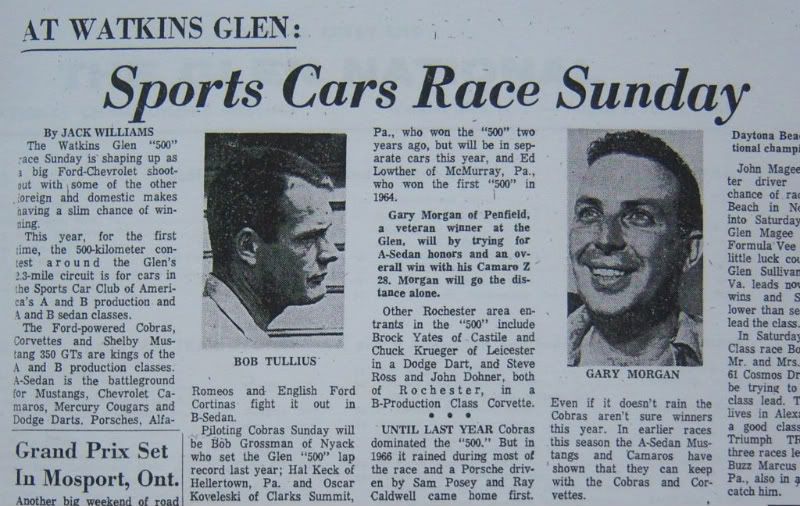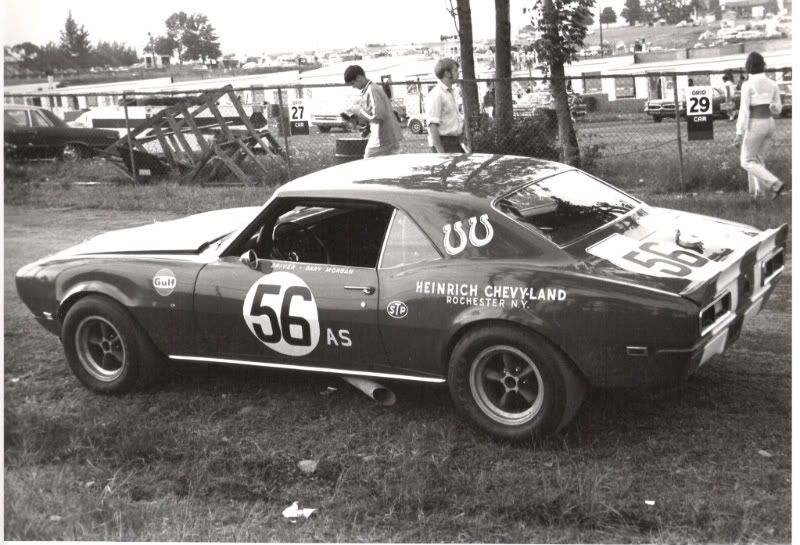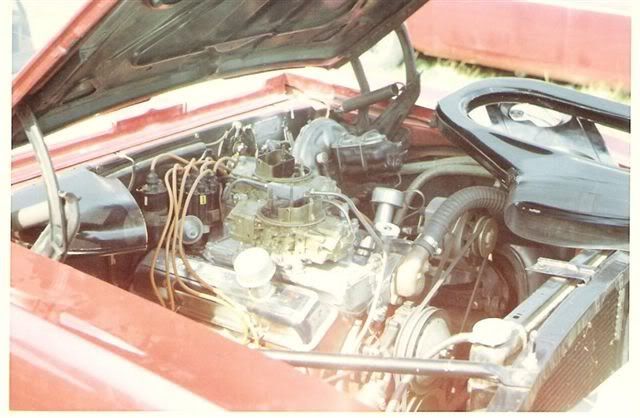Yes, no more Trans-Am races. We found out that it was foolish to race the car when the overheating problem had not really been solved. We had melted two pistons and had to tear the engine down and take it back to Jess Haelen for a rebuild. This is when we put the 140 cam in. We got it back fairly soon and took it to Watkins Glen for the Glen 500. I believe this may have been when we changed the springs as well, fronts from 864lb/in. down to 615lb/in. and rear down from 356 to 300lb/in. rate. Once we got to the Glen, the car handled very well. All of the handling problems were gone, but the car was still overheating badly. My old Cobra friend, Hal Keck, came by to visit and we told him of the problem. He asked if we wanted his mechanic, Red, to take a look at the carb as Red had a lot of Holley carburetor experience. Red came over and in no time at all had the carb apart and found that the info we had received from GM on the jet sizes was wrong! Instead of .072 primary and .077 secondary, they should have told us #72 and #77 jet sizes. We had a set of small drills and my father and Red drilled out the jets to as close as they could guess they should be and out on the track I went. What a difference, no overheating and it handled!
 Watkins Glen 500 article, August 1967 Courtesy of Gary Morgan Collection
Watkins Glen 500 article, August 1967 Courtesy of Gary Morgan Collection On race day we felt real good about the car. The race was 500k or 310.5mi. for AP, BP, and A, B Sedans. We started 9th behind several Cobras, big block Vettes etc and moved up to 6th OA and 1st in A-Sedan by lap 32. We were then 5th OA and still 1st in A-Sedan on lap 37 and held that position until lap 62 when the water pump let go. It must have been damaged by all the overheating at Lime Rock and Mid-Ohio, and we never thought to change it. We went to one more event in 1967. It was at Watkins Glen and there were three races over the weekend. We won all three and set a new lap record for A-Sedan on the Watkins Glen course. We previously had the B production record with the Vette.
Over the winter we converted the car from a 1967 to a 1968 by changing everything that was obvious (Heinrich paid for this) and added the cross ram intake. We did not change the brakes (didn’t add 4-wheel discs – JM) as I felt we really did not have a brake problem. It would have been at our expense, and money was still a problem.
 Updated to look like a '68 for the '68 racing season. Photo: Gary Morgan Collection
Updated to look like a '68 for the '68 racing season. Photo: Gary Morgan Collection One day, in very early spring, my wife Sue called me at Kodak and said she had received a phone call from a guy named Chic Blood who worked for Young and Rubican advertising in N.Y. City. She said they wanted to talk to me about doing a TV commercial. I thought she was kidding me because I couldn't believe my luck was changing. She said this guy would call me back at 8:00 PM that evening to discuss the deal. Meanwhile, I contacted a friend that was in local advertising and asked what he thought I should charge for my services. He gave me a number that he thought would be appropriate. Mr. Blood called right at 8:00PM and told me the commercial was for Gulf gasoline and would be filmed at the Bridgehampton race course. I was to spend three days doing the commercial and would have to bring a crew and a track safety person. Now the difficult part, he asked “how much?”. I didn't want to go too cheap, but I also didn't want to lose the opportunity, so I thought, well I can always come down. I took a deep breath and tripled what my friend had told me. I said $2500.00 plus expenses. His answer was he was authorized to approve $2000.00 and if I really had to have $2500.00 he would have to call his boss and get approval to do it. He called back within the hour and said I would be receiving a contract within a week and would have a week to sign and return it.
The advertising agency got my name from Brock Yates who was, and I think is still, a member of the same SCCA region that I am. I had loaned Brock a trailer when he had the Ray Nichols Dodge Dart and needed to take it somewhere down south. Later, when he had the CAR & DRIVER Mustang, I gave him a new Goodyear race tire after they had ruined one in practice. I guess giving the ad agency my name was his way of paying me back. It was very gracious of him to do this for me as the expenses for the Camaro were far more than anything we raced before and these dollars would sure help.
We got all of the arrangements worked out with Gulf and, as this was early in the year and we had freshly rebuilt the engine over the winter, we left for Bridgehampton, Long Island to make the commercial. We had to be there on Monday and were supposed to finish on Wednesday. We had drained all of the Sunoco concentrate out of the tank and there was a Gulf station just down the road from the track that we were supposed to use for our fuel. This worked out great as we had 10 gallon cans that we would fill up and we made sure we always got enough to add a can or two to the Chevy wagon tow car. (Later when I got my last check, there was a $70.00 dollar deduction for gas for the tow car. I guess we didn't fool anyone. I sure felt like an ass).
During the making of the commercial I had to guarantee that the car went at least 140MPH so they could state that in the ad. The film people were very good to work with and we had to start at 6AM every day. They would have a big catered lunch each day and treat us to dinner in the evening. On the second day, they had a sound man there who had to lie on the floor of the car so he would not be seen in the film. This guy thought he was a real hot shot and made some comment to me that I thought was a put down. I think he said something like "you don't even look like a race driver". Well, I mean to say I gave this guy a ride that was far more than necessary for what we were trying to accomplish. When we were done with the segment he got out of the car with his hands shaking and a very pale complexion, mumbling something about his wife and kids. The next day we got a late start with the filming because we had to wait for a new sound man. Seems the smart ass had quit for some reason! Well, this was the third day and we were supposed to finish up but the gremlins were at it again. The Camaro started overheating and my father diagnosed it as a cracked cylinder wall. By the contract we had to finish the commercial, so Dad went to an auto parts store and found some block sealer that was intended for diesel truck engines. He put in enough to seal a small fleet of trucks, loosened the radiator cap and by noon we were ready to restart. We had to carry over the finish until Thursday, but we made the car last, loaded up, and headed back for the long drive home to Rochester.
It is now early in the 1968 season. We tear the engine down and find old Dad was right. We had a cracked cylinder wall in the engine that had just been rebuilt before the trip to Bridgehampton. A call was placed to Barney Krass (our contact at GM for a new short block) and we got a response that there would be a wait, as short blocks were not available at this time. We waited several weeks and called again. Same answer. Finally we recalled that when we visited the Tech Center in 1966, Barney had said he used a lot of Kodak 16mm movie film. Since all four of us that were working on the car were Kodak employees, we put out the feelers for some test film and shipped off about ten rolls to Barney. Son of a gun, within about a week we had a new short block! Later that year, after we had found some more test film and sent it off, I started getting phone calls whenever there were new items available from GM. I had a friend that had raced solid axle Vettes when I was racing the Stingray. His name was Steve Elfenbien and he had switched to racing Camaros. At a race in 1969 at Lime Rock we were talking about the cars and I asked him if he had any trouble getting parts. He said he did for a while but once he started sending something called "Red Herring" to the same address I sent film to, things got better! We had a good laugh about this and wondered what kind of a deal some of the other racers must have made to get their parts, but we decided not to pursue it any further for fear of losing what we had.
By the time we got the new block and had it prepared, it was getting late in the season. Money was low and so were our spirits. We made it to two regional races at the Glen, set another lap record, won three races at the two events and hung it up for the year.
 Engine shot shows the 2x4 crossram and super rare cowl plenum duct. Photo: Gary Morgan Collection
Engine shot shows the 2x4 crossram and super rare cowl plenum duct. Photo: Gary Morgan Collection 1969, off we go again. At the Glen 100, we won 1st OA on both the Saturday and Sunday races. We came in 2nd at the Glen National, 1st at Lime Rock National after a three car wreck going into the first turn that flattened our right door and quarter panel, (I caught and passed everybody), 2nd at Pocono National with a real bad handling problem that showed up on race day. I later found out one of my competitors had adjusted my toe-in the night before the race. I also found out he was running a 350 CI engine with the block ID changed to look like 302 ID. This was the car that I came in 2nd to at the Glen and Pocono. One of his crew members later told me the preceding information. The last race of the year was a regional at the Glen and we were 1st in both the Saturday and Sunday races.
 On the track at Watkins Glen. Photo: Gary Morgan Collection
On the track at Watkins Glen. Photo: Gary Morgan Collection After the last race I did some thinking. I was thirty-three years old and had raced for fourteen years. I had a wife that had dedicated her total ten years of marriage to racing, always helping and sacrificing without complaining. I had two young sons, one five and one three. My father was fifty-nine years old and was still working around the clock on the cars if necessary. On top of that, people at Kodak were asking when I was going to stop racing.
One afternoon in the late fall of 1969 while at work, I picked up the phone and called Jon Heinrich. I thanked him for all the help he had given us and told him I had decided to stop racing. Jon said he was disappointed but he understood. He also offered me two new cars for the next year. He said he had been thinking it would be nice to race both a Camaro and a Corvette out of his dealership. I said thanks but I had made up my mind. Jon, always being a gentleman, said he would sell the Camaro and split the money with me as he was aware we had a significant investment in it. He asked what I thought it would be worth as a race car and I told him I would guess it would be worth six to seven thousand dollars at that time. He agreed and said I would be hearing from him. In a short time I heard through the grapevine that a local racer named Kent Fellows had bought the car. I called Heinrich’s and found out Jon was out of town and one of his salesmen had sold the car for thirty-five hundred dollars without checking with Jon. What a deal! That meant I would be getting seventeen-fifty instead of the three thousand I had been hoping for. All during the time we were racing after I got married, my wife Sue had paid the bills. She robbed one account to pay another and shuffled things so we could keep going and never complained. She now came to me in tears and asked that since we were not racing anymore, could I take over paying the bills as she just could not do it anymore. The check for seventeen-fifty came and we sat down to figure our bills. When we were done we found we had one hundred dollars to our name. Well, at least we weren't broke!